I log how much power it takes to charge my Ego batteries after I use them. I’m using this as a stand-in for how much capacity they retain over time. You should know that I have a large lawn (in Florida) and cycle these batteries at least once a week (more in the summer) so these batteries are getting more of a workout than if you had a small city lot that you could mow a few times before charging the battery.
I have two 7.5 AH batteries (one bought before the other). They took 410 watt hours to recharge when new. My older battery has three years of use, and has 63% of it’s original capacity (260 w/h). The drop from year 2 to year 3 was from 75->63% [The batteries have a 3 year warranty, so the first battery is now out of warranty.]
My second battery appears to be following the same general trajectory, although it’s capacity is just slightly less than the first battery (at the same years in service mark).
For the bar chart above I averaged the capacity of all measurements in a particular year, but if you graph all measurements you can see that they are generally decreasing over time (although the batteries do sometimes go “up” in capacity, possibly due to ambient temperatures). The following graph is for my 2nd 7.5AH battery (manufacture date of 2018).
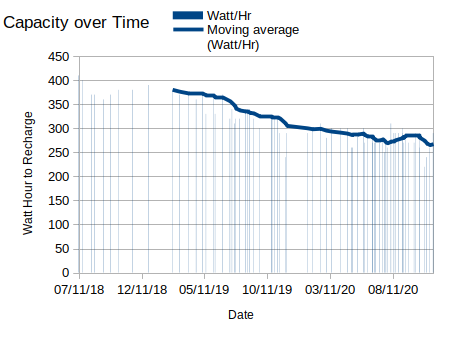
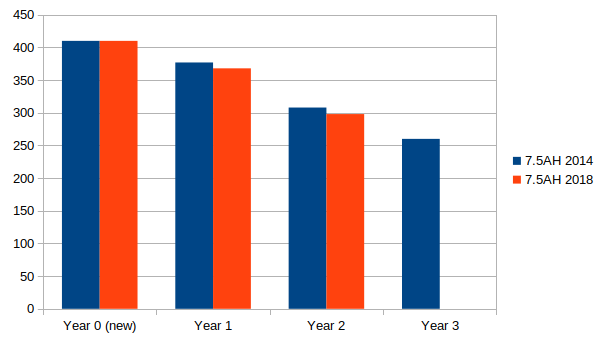
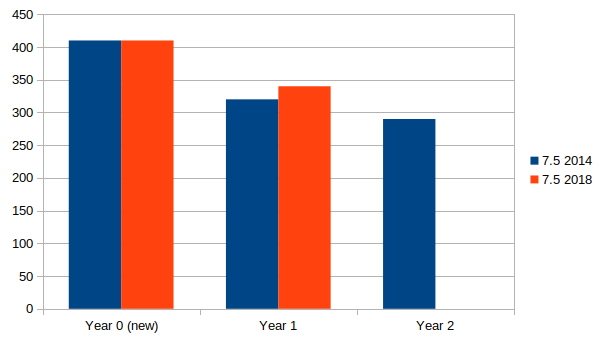
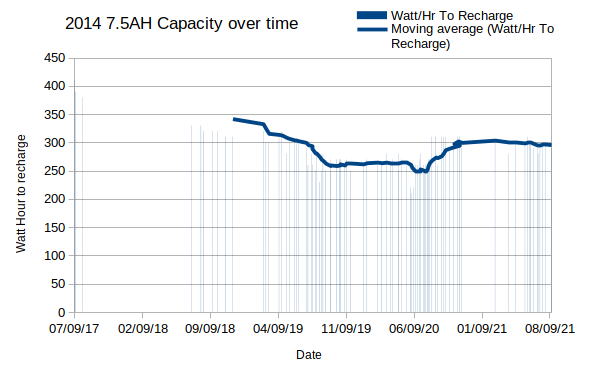
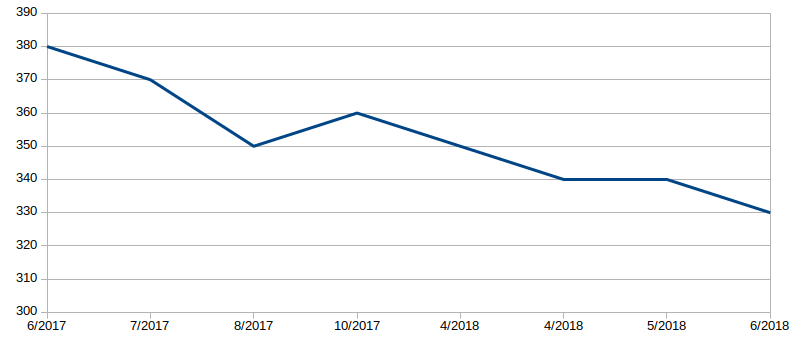

This is great work here. As an EGO owner of many tools, hitting the 4 year mark now.. I can see the drop of my 7.5Ah battery, lasts about as long as the 5.0Ah ones I switch off with while I mow my 0.5 acre lawn. Mine get discharged once to twice a week from April through September. I wonder how folks who take their electric cars looking 40% of their range on 3 years..
The (3) EV’s I’ve owned have not had this level of battery degradation. Mostly because people don’t run them down to zero every time they use them, but also because the chemistry of those cells is optimized for longevity, as opposed to maximizing energy storage/density). I think the EGO batteries are more accurately compared to laptop batteries (down to 50% after 2 years) than the larger EV batteries.
Do your batteries have the “fuel gauge” (battery level indicator of 5 bars arranged in a circle)? Do they reflect the diminished capacity, e.g., do they now only show 4 solid bars when fully charged? Thanks for tracking and posting your findings.
No, all of my batteries (so far) are the older style with a single light ring (no fuel gauge). My understanding is that the new fuel gauge shows the “state of charge” and not the “state of health” of the batteries….so even if the battery is at half capacity, it will show “full charged” when fully charged. [This is how most battery gauges work, as they are typically based upon voltage, and not amp hours in/out. When fully charged the voltage is the same, even if the capacity drops faster.]
I have 7 tools (chain saw, string trimmer, multi tool, snowblower, blower, lawn mower, hedge trimmer) and I have 10 eGo batteries of differing Ah capacity, some are as much as 8 years old. I plan to use this method to determine what their current individual status is. We have a very large driveway and hardscape, plus I often take care of the neighbor yard so one of the reasons is to pair batteries with similar remaining capacity in the snowblower so I don’t have one giving out well before another. Another is to use the batteries in sequence from longest lasting to shortest to minimize battery changes. I’ll use colored dots as code. Thanks for the tip, I’ve wondered for a long time how I can calculate remaining life and performance.
Glad to be of help.
I on my third battery with the first two each replaced last month of the 3 year warranty. Have a 1 acre lot that gets mowed a lot in the spring and less in the summer. My third remaining battery is lasting less and will be at 3 years in about a month.